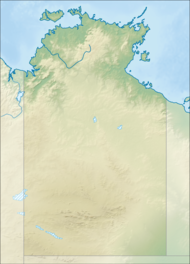Top End
This article needs additional citations for verification. (January 2007) |
| Top End NASA satellite image of the Top End | |||||||||
|---|---|---|---|---|---|---|---|---|---|
| Coordinates | 13°23′S 132°58′E / 13.39°S 132.96°E | ||||||||
| Area | 245,000 km2 (94,595.0 sq mi) | ||||||||
| Time zone | ACST (UTC+09:30) | ||||||||
| |||||||||
The Top End of Australia's Northern Territory is a geographical region encompassing the northernmost section of the Northern Territory, which aside from the Cape York Peninsula is the northernmost part of the Australian continent. It covers a rather vaguely defined area of about 245,000 km² (95,000 sq mi) behind the northern coast from the Northern Territory capital of Darwin across to Arnhem Land with the Indian Ocean on the west, the Arafura Sea to the north, and the Gulf of Carpentaria to the east, and with the almost waterless semi-arid interior of Australia to the south, beyond the huge Kakadu National Park.[1]
The Top End contains both of the Territory's cities and one of its major towns,
The landscape is relatively flat with river floodplains and grasslands with eucalyptus trees along with rocky areas and patches of rainforest, and in western Arnhem Land a high rugged sandstone plateau cut through with gorges, much of which is in Kakadu National Park. The rivers that form the wetlands include the South and East Alligator Rivers, Mary River, and the Glyde River. The climate is tropical monsoon with a wet and dry season, bringing the highest rainfall in northern Australia (over 1,200 mm (47 in) per year). Temperatures do not fluctuate widely throughout the year.
There are a number of islands off the Top End coast including the Tiwi Islands (Bathurst Island and Melville Island), and Groote Eylandt as well as many smaller ones.
Flora
Most
Fauna
This area is home to unique wildlife. The rivers and estuaries are home to large populations of both
Threats and preservation
The landscape is well preserved and most of the area is traditionally managed by Aboriginal land trusts, including Kakadu National Park, which is Australia's largest national park and a World Heritage Site.[1] Although some populations have declined, there have been no major extinctions of wildlife in this area. Darwin, though, is a growing city and a base for agriculture and mining, both of which threaten habitats. Introduced plants and animals, such as the water buffalo, are also changing natural habitats, and there has been criticism of the way the local population has changed the fire regimes used to control the bush foliage, in which large areas are burnt each year and allowed to renew. Also there was a large aboriginal trade in that area [clarification needed] which has mostly settled down.
References
- ^ . Retrieved 12 August 2018.
- ISSN 1049-8001.
- ^ "Arnhem Land tropical savanna". Terrestrial Ecoregions. World Wildlife Fund.
- ISBN 9780691161464.
External links
 Top End travel guide from Wikivoyage
Top End travel guide from Wikivoyage

